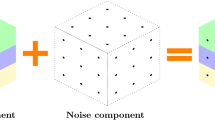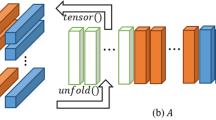Abstract
Many kinds of real-world multi-way signal, like color images, videos, etc., are represented in tensor form and may often be corrupted by outliers. To recover an unknown signal tensor corrupted by outliers, tensor robust principal component analysis (TRPCA) serves as a robust tensorial modification of the fundamental PCA. Recently, a successful TRPCA model based on the tubal nuclear norm (TNN) (Lu et al. in IEEE Trans Pattern Anal Mach Intell 42:925–938, 2019) has attracted much attention thanks to its superiority in many applications. However, TNN is computationally expensive due to the requirement of full singular value decompositions, seriously limiting its scalability to large tensors. To address this issue, we propose a new TRPCA model which adopts a factorization strategy. Algorithmically, an algorithm based on the non-convex augmented Lagrangian method is developed with convergence guarantee. Theoretically, we rigorously establish the sub-optimality of the proposed algorithm. We also extend the proposed model to the robust tensor completion problem. Both the effectiveness and efficiency of the proposed algorithm is demonstrated through extensive experiments on both synthetic and real data sets.











Similar content being viewed by others
Notes
References
Boyd S, Parikh N, Chu E, Peleato B, Eckstein J (2011) Distributed optimization and statistical learning via the alternating direction method of multipliers. Foundations and Trends®. Mach Learn 3(1):1–122
Candès EJ, Li X, Ma Y, Wright J (2011) Robust principal component analysis? J ACM (JACM) 58(3):11
Candès EJ, Tao T (2010) The power of convex relaxation: near-optimal matrix completion. IEEE Trans Inf Theory 56(5):2053–2080
Fazel M (2002) Matrix rank minimization with applications. Ph.D. thesis, Stanford University
Foucart S, Rauhut H (2013) A mathematical introduction to compressive sensing, vol 1. Birkhäuser, Basel
Friedland S, Lim L (2017) Nuclear norm of higher-order tensors. Math Comput 87(311):1255–1281
Goldfarb D, Qin Z (2014) Robust low-rank tensor recovery: models and algorithms. SIAM J Matrix Anal Appl 35(1):225–253
Harshman RA (1970) Foundations of the parafac procedure: models and conditions for an “explanatory” multi-modal factor analysis
Hillar CJ, Lim L (2009) Most tensor problems are np-hard. J ACM 60(6):45
Huang B, Mu C, Goldfarb D, Wright J (2015) Provable models for robust low-rank tensor completion. Pac J Optim 11(2):339–364
Jiang Q, Ng M (2019) Robust low-tubal-rank tensor completion via convex optimization. In: Proceedings of the 28th international joint conference on artificial intelligence. AAAI Press, Macao, China, pp 2649–2655
Kilmer ME, Braman K, Hao N, Hoover RC (2013) Third-order tensors as operators on matrices: a theoretical and computational framework with applications in imaging. SIAM J Matrix Anal Appl 34(1):148–172
Kolda TG, Bader BW (2009) Tensor decompositions and applications. SIAM Rev 51(3):455–500
Lai Z, Xu Y, Chen Q, Yang J, Zhang D (2014) Multilinear sparse principal component analysis. IEEE Trans Neural Netw 25(10):1942–1950
Lai Z, Xu Y, Yang J, Tang J, Zhang D (2013) Sparse tensor discriminant analysis. IEEE Trans Image Process 22(10):3904–3915
Lin Z, Chen M, Ma Y (2010) The augmented Lagrange multiplier method for exact recovery of corrupted low-rank matrices. arXiv preprint arXiv:1009.5055
Liu G, Yan S (2012) Active subspace: toward scalable low-rank learning. Neural Comput 24(12):3371–3394
Liu J, Musialski P, Wonka P, Ye J (2013) Tensor completion for estimating missing values in visual data. IEEE Trans Pattern Anal Mach Intell 35(1):208–220
Liu X, Aeron S, Aggarwal V, Wang X (2020) Low-tubal-rank tensor completion using alternating minimization. IEEE Trans Inf Theory 66(3):1714–1737
Liu Y, Jiao L, Shang F (2013) A fast tri-factorization method for low-rank matrix recovery and completion. Pattern Recognit 46(1):163–173
Liu Z, Lai Z, Ou W, Zhang K, Zheng R (2020) Structured optimal graph based sparse feature extraction for semi-supervised learning. Signal Process 170:107456
Liu Z, Wang J, Liu G, Zhang L (2019) Discriminative low-rank preserving projection for dimensionality reduction. Appl Soft Comput 85:105768
Lu C, Feng J, Chen Y, Liu W, Lin Z, Yan S (2016) Tensor robust principal component analysis: Exact recovery of corrupted low-rank tensors via convex optimization. In: Proceedings of the IEEE conference on computer vision and pattern recognition. IEEE, Las Vegas, USA, pp 5249-5257
Lu C, Feng J, Liu W, Lin Z, Yan S et al (2019) Tensor robust principal component analysis with a new tensor nuclear norm. IEEE Trans Pattern Anal Mach Intell 42:925–938
Moosmann F, Stiller C (2013) Joint self-localization and tracking of generic objects in 3d range data. In: Proceedings of the IEEE international conference on robotics and automation. IEEE, Karlsruhe, Germany, pp 1138–1144
Peng Y, Lu BL (2017) Discriminative extreme learning machine with supervised sparsity preserving for image classification. Neurocomputing 261:242–252
Peng Y, Lu BL (2017) Robust structured sparse representation via half-quadratic optimization for face recognition. Multimed Tools Appl 76(6):8859–8880
Romera-Paredes B, Pontil M (2013) A new convex relaxation for tensor completion. In: Proceedings of advances in neural information processing systems. The Neural Information Processing Systems Foundation, Lake Tahoe, USA, pp 2967–2975
Tucker LR (1966) Some mathematical notes on three-mode factor analysis. Psychometrika 31(3):279–311
Wang A, Jin Z (2017) Near-optimal noisy low-tubal-rank tensor completion via singular tube thresholding. In: Proceedings of the IEEE international conference on data mining workshop (ICDMW). IEEE, New Orleans, USA, pp 553–560
Wang A, Jin Z, Tang G (2020) Robust tensor decomposition via t-SVD: near-optimal statistical guarantee and scalable algorithms. Signal Process 167:107319. https://doi.org/10.1016/j.sigpro.2019.107319
Wang A, Jin Z, Yang J (2019) A factorization strategy for tensor robust PCA. In: 2019 5th IAPR Asian conference on pattern recognition (ACPR). IAPR, Auckland, New Zealand, pp 424–437
Wang A, Lai Z, Jin Z (2019) Noisy low-tubal-rank tensor completion. Neurocomputing 330:267–279
Wang A, Li C, Jin Z, Zhao Q (2020) Robust tensor decomposition via orientation invariant tubal nuclear norms. In: Proceedings of AAAI conference on artiicial intelligence. AAAI Press, New York, USA, pp 6102–6109
Wang Z, Bovik AC, Sheikh HR, Simoncelli EP (2004) Image quality assessment: from error visibility to structural similarity. IEEE Trans Image Process 13(4):600–612
Wu T, Bajwa WU (2018) A low tensor-rank representation approach for clustering of imaging data. IEEE Signal Process Lett 25(8):1196–1200
Xie Y, Tao D, Zhang W, Liu Y, Zhang L, Qu Y (2018) On unifying multi-view self-representations for clustering by tensor multi-rank minimization. Int J Comput Vis 126(11):1157–1179
Xu Y, Hao R, Yin W, Su Z (2015) Parallel matrix factorization for low-rank tensor completion. Inverse Probl Imaging 9(2):601–624
Xue J, Zhao Y, Liao W, Chan JCW (2018) Total variation and rank-1 constraint rpca for background subtraction. IEEE Access 6:49955–49966
Xue J, Zhao Y, Liao W, Chan JCW (2019) Nonconvex tensor rank minimization and its applications to tensor recovery. Inf Sci 503:109–128
Xue J, Zhao Y, Liao W, Chan JCW, Kong SG (2020) Enhanced sparsity prior model for low-rank tensor completion. IEEE Trans Neural Netw Learn Syst. https://doi.org/10.1109/TNNLS.2019.2956153
Zhang F, Yang G, Yang Z, Wan M (2018) Robust recovery of corrupted image data based on \(l_{1-2}\) metric. IEEE Access 6:5848–5855
Zhang Z, Aeron S (2017) Exact tensor completion using t-SVD. IEEE Trans Signal Process 65(6):1511–1526
Zhang Z, Ely G, Aeron S, Hao N, Kilmer M (2014) Novel methods for multilinear data completion and de-noising based on tensor SVD. In: Proceedings of the IEEE conference on computer vision and pattern recognition. IEEE, Columbus, USA, pp 3842–3849
Zhou P, Feng J (2017) Outlier-robust tensor PCA. In: Proceedings of the IEEE conference on computer vision and pattern recognition. IEEE, Honolulu, USA, pp 3938–3946
Acknowledgements
The authors would like to thank Prof. Qibin Zhao, Ms. Jin Wang, Mr. Bo Wang and Dr. Dongxu Wei for their long time support. This work is partially supported by National Natural Science Foundation of China [Grant nos. 61872188, U1713208, 61972204, 61672287, 61861136011, 61773215, 61703209,61972212], by the Natural Science Foundation of Guangdong Province [Grant nos. 2020A1515010671, 2017A030313367], and by the Natural Science Foundation of Jiangsu Province [Grant no. BK20190089].
Author information
Authors and Affiliations
Corresponding author
Additional information
Publisher's Note
Springer Nature remains neutral with regard to jurisdictional claims in published maps and institutional affiliations.
Part of this work [32] has been presented in 5th IAPR Asian Conference on Pattern Recognition (ACPR), 26-29 November 2019, Auckland, New Zealand.
Rights and permissions
About this article
Cite this article
Wang, AD., Jin, Z. & Yang, JY. A faster tensor robust PCA via tensor factorization. Int. J. Mach. Learn. & Cyber. 11, 2771–2791 (2020). https://doi.org/10.1007/s13042-020-01150-2
Received:
Accepted:
Published:
Issue Date:
DOI: https://doi.org/10.1007/s13042-020-01150-2




